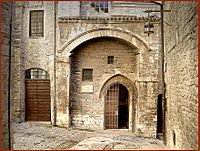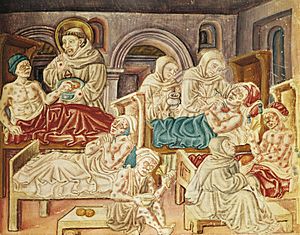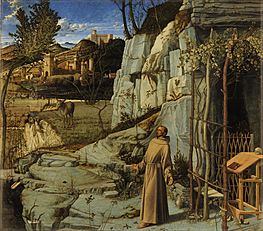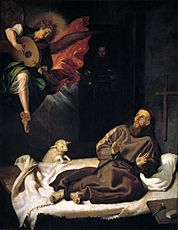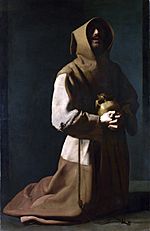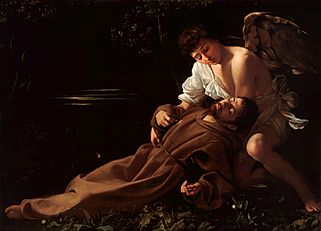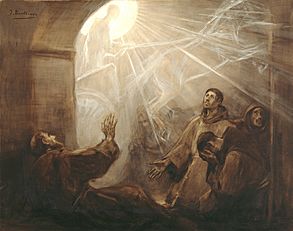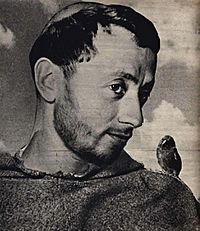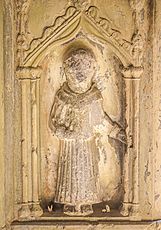Francis of Assisi facts for kids
Quick facts for kids SaintFrancis of Assisi OFM |
|
|---|---|
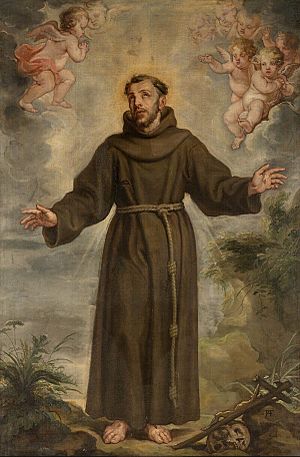
A portrait of Saint Francis by Philip Fruytiers
|
|
| Founder of the Franciscan Order Confessor of the Faith and Stigmatist |
|
| Born | Giovanni di Pietro di Bernardone 1181 or 1182 Assisi, Duchy of Spoleto, Holy Roman Empire |
| Died | 3 October 1226 (aged approximately 44 years) Assisi, Umbria, Papal States |
| Venerated in | |
| Canonized | 16 July 1228, Assisi, Papal States by Pope Gregory IX |
| Major shrine | Basilica of San Francesco d'Assisi |
| Feast | 4 October |
| Attributes | Franciscan habit, birds, animals, stigmata, crucifix, book, and a skull |
| Patronage | Franciscan Order, animals, merchants, ecology, stowaways, Aguada, Naga, Cebu, General Trias, and Italy |
Giovanni di Pietro di Bernardone, known as Francis of Assisi (born around 1181 – died 3 October 1226), was an Italian Catholic friar. He started the Franciscans, a religious group. Francis was inspired to live a simple life, traveling and teaching about God. He is one of the most respected figures in Christianity. Pope Gregory IX made him a saint on 16 July 1228. People often see him pictured in a simple robe with a rope belt.
In 1219, Francis traveled to Egypt. He hoped to talk to the sultan al-Kamil and help end the Fifth Crusade. In 1223, he created the first live nativity scene in Greccio, Italy. This was part of the yearly Christmas celebration.
He founded several religious groups. These include the men's Order of Friars Minor, the women's Order of St. Clare, and the Third Order of St. Francis. He also started the Custody of the Holy Land. After the Pope approved his community, Francis spent more time away from public life.
Francis is known as the patron saint of animals and the environment. Many churches now bless animals on his feast day, October 4. He was also very devoted to the Eucharist. Along with Catherine of Siena, he is a patron saint of Italy.
Contents
Who Was Saint Francis of Assisi?
Francis's Early Life and Big Changes
Francis of Assisi was born in late 1181. His father, Pietro di Bernardone, was a rich silk merchant from Italy. His mother, Pica de Bourlemont, was a noblewoman from France. Francis was born in Assisi while his father was away on business. His mother had him baptized as Giovanni. When his father returned, he started calling his son Francesco, meaning "Frenchman." This might have been because of his success in France.
Francis grew up living a fun and wealthy life. He loved fine clothes and spent money freely. He enjoyed the songs of troubadours, who were traveling singers. Even though he seemed happy, Francis sometimes felt unhappy with the world. One story tells how he gave all his money to a beggar. His friends made fun of him, and his father was very angry.
Around 1202, Francis joined a fight against Perugia. He was captured and spent a year as a prisoner. During this time, he became sick and started to think about his life. After returning to Assisi in 1203, he went back to his old ways. But in 1205, a strange vision made him lose interest in worldly things. He began to avoid parties and sports. When a friend asked if he was thinking of marrying, Francis said yes, to "Lady Poverty." This meant he wanted to live a simple life.
Francis's Spiritual Journey
Francis went on a pilgrimage to Rome. There, he joined the poor in begging at St. Peter's Basilica. He spent time alone, praying for spiritual guidance. He said he had a special vision of Jesus Christ in a ruined chapel called San Damiano. In this vision, the cross spoke to him, saying, "Francis, go and repair My church."
Francis thought this meant the old church he was in. So, he sold some cloth from his father's shop to help the priest. But the priest refused the money. Francis threw the coins on the floor. To avoid his father's anger, Francis hid in a cave for a month. When he returned, his father beat him and locked him up. His mother freed him, and Francis went back to San Damiano.
His father then tried to make Francis give up his inheritance. During a legal meeting with the Bishop of Assisi, Francis gave up everything from his father. For the next few months, Francis lived as a beggar. He worked as a kitchen helper at a monastery. Then he went to Gubbio, where a friend gave him clothes for a pilgrim.
Returning to Assisi, he begged for stones to fix San Damiano. He carried the stones himself and rebuilt the chapel. Over two years, he fixed several other ruined chapels. One of these was the Porziuncola, a small chapel that became his favorite place. He also began to care for lepers in hospitals near Assisi.
Starting the Franciscan Orders
The Friars Minor
One morning in February 1208, Francis was at Mass in the Porziuncola chapel. The Gospel reading inspired him to live a life of poverty. He put on a simple woolen tunic, like the poorest farmers wore. He tied it with a knotted rope. Then, he began to preach to people about being sorry for their sins, loving each other, and peace. Francis's preaching to ordinary people was unusual because he did not have official permission.
His example attracted others. Within a year, Francis had eleven followers. These brothers lived simply in a deserted building near Assisi. They spent much of their time traveling through the mountains of Umbria. Their strong messages made a deep impression on the people they met.
In 1209, Francis wrote a simple rule for his followers, called the Regula primitiva. It was based on Bible verses. The rule was "to follow the teachings of our Lord Jesus Christ and to walk in his footsteps." He then took his eleven followers to Rome. They wanted Pope Innocent III to approve their new religious order. A cardinal, who was the Pope's confessor, helped Francis.
After several days, the Pope agreed to let the group begin informally. He said they could return for official approval later. The group also had their hair cut in a special way, showing they were part of the Church. This was important because it showed they followed Church authority. It also stopped them from being accused of heresy, like the Waldensians had been. Some of the Pope's advisors thought Francis's way of life was too hard. But the Pope had a dream where he saw Francis holding up a church. So, he decided to support Francis's order.
This happened on April 16, 1210. It was the official start of the Franciscan Order. The group, called the "Lesser Brothers" (Order of Friars Minor), lived at the Porziuncola. They preached first in Umbria, then all over Italy. Francis later became a deacon, but not a priest.
The Poor Clares and Third Order
The new order grew quickly. In 1211, a young noblewoman named Clare of Assisi heard Francis preach. She wanted to live like the friars. On Palm Sunday, March 28, 1212, Clare secretly left her home. Francis welcomed her at the Porziuncola. He gave Clare a religious habit, like his own. This started the Order of Poor Clares.
Francis found a place for Clare, her younger sister Caterina, and other young women. This became the first monastery of the Second Franciscan Order, now known as Poor Clares.
For people who could not leave their homes and jobs, Francis later created the Third Order of Brothers and Sisters of Penance. This group was for ordinary people or clergy. They did not leave the world or take special religious vows. Instead, they followed Franciscan ideas in their daily lives. Soon, this Third Order, now called the Secular Franciscan Order, spread beyond Italy.
Francis's Journeys and Missions
Francis wanted to share the Gospel with everyone. He tried several times to travel outside Italy. In 1212, he set out for Jerusalem, but a storm shipwrecked his boat. He had to return to Italy. In 1213, he received the mountain of La Verna as a gift. It became one of his favorite places for prayer.
That same year, Francis sailed for Morocco. But he became ill and had to stop his journey in Spain.
In 1219, Francis went to Egypt during the Fifth Crusade. He hoped to convert the Sultan of Egypt, al-Kamil, or become a martyr. A Crusader army had been fighting in Egypt for over a year. Francis and a companion crossed into the Muslim camp. They stayed there for a few days. The Sultan welcomed Francis kindly, and Francis preached to the Muslims. He returned unharmed. Later stories say the Sultan gave Francis permission to visit holy places in the Holy Land. Franciscans have been present in the Holy Land almost continuously since 1217.
Reorganizing the Franciscan Order
The order of friars grew very large. It was divided into different regions. Groups were sent to France, Germany, Hungary, Spain, and the East. When Francis heard that five brothers had died in Morocco, he returned to Italy. Cardinal Ugolino di Conti became the protector of the order.
The Franciscan Order had grown faster than any other religious group before it. But its organization was not keeping up. Francis's simple rule and example were not enough to manage it. So, Francis wrote a new, more detailed rule. This was the "First Rule" (Regula prima). It still focused on poverty and living like the apostles. But it also added more structure. However, the Pope never officially approved this rule.
On September 29, 1220, Francis gave control of the order to Brother Peter Catani. But Peter died only five months later.
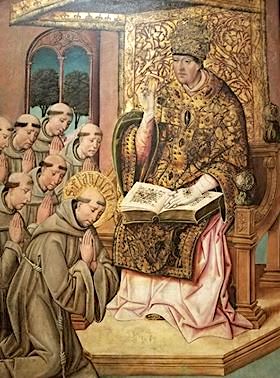
Brother Elias took over from Brother Peter. Two years later, Francis changed the "First Rule" again. This became the "Second Rule" or "Rule With a Bull." Pope Honorius III approved it on November 29, 1223. This became the official rule for the order. It told the friars "to observe the Holy Gospel of our Lord Jesus Christ, living in obedience without anything of our own and in chastity." It also set rules for discipline and joining the order. After the Pope approved this rule, Francis spent less time on managing the order.
Stigmata, Final Days, and Sainthood
While praying on the mountain of Verna, Francis had a vision around September 13, 1224. He was preparing for a special feast day. During this vision, he is said to have received the stigmata. This means he got the five wounds of Christ on his body. Brother Leo, who was with Francis, wrote about this event. It was the first clear report of stigmata.
Francis suffered from these wounds and an eye disease. He tried to get help in several cities but it did not work. Finally, he was brought back to a hut near the Porziuncola. He spent his last days there, dictating his spiritual wishes. He died on the evening of Saturday, October 3, 1226, singing a psalm.
On July 16, 1228, Pope Gregory IX declared Francis a saint. The next day, the Pope started building the Basilica of St. Francis in Assisi. Francis was buried on May 25, 1230, under the Lower Basilica. His tomb was hidden to protect it from invaders. It was found again in 1818. His remains were later placed in a glass urn in the old stone tomb in 1978.
Francis's Character and Lasting Impact
Francis wanted to be like Christ and follow his teachings exactly. This helps us understand Francis's personality. He deeply respected the Eucharist and the priests who performed the sacrament. He taught that "Your God is of your flesh, He lives in your nearest neighbor, in every man."
He and his followers loved and respected poverty. It was so important to him that in his last writing, he said that living without personal or group possessions was key for his order.
Francis believed that nature showed God's beauty. He called all creatures his "brothers" and "sisters." He even preached to birds. He supposedly convinced a wolf in Gubbio to stop attacking people if they fed it. His strong feeling of brotherhood under God included everyone. He said he would not be a friend of Christ if he did not care for those Christ died for.
Francis's visit to Egypt and his attempt to make peace with the Muslim world had a big impact. Even after his death, Franciscans were the only Catholics allowed to stay in the Holy Land. They were recognized as "Custodians of the Holy Land" by the Catholic Church.
Around 1220, Francis celebrated Christmas in Greccio. He set up the first known presepio or crèche (Nativity scene). He used real animals to create a living scene. This helped people imagine the birth of Jesus in a very real way. His biographers say he used only a straw-filled manger between a real ox and donkey. It was simple and beautiful.
Nature and the Environment
Francis taught that God created the world good and beautiful. But it needs healing because of human sin. He saw God in nature. "St. Francis was a great lover of God's creation." In his prayer, the Canticle of the Sun, he thanks God for Brother Sun, Sister Moon, Brother Wind, Water, Fire, and Earth. He saw all these as praising God.
Many stories about Francis show his great love for animals and nature. The "Fioretti" ("Little Flowers") are old legends about him. One story says Francis was traveling when he saw many birds in the trees. He told his friends to "wait for me while I go to preach to my sisters the birds." The birds gathered around him, listening to his voice. None of them flew away. He is often shown with a bird in his hand.
Another legend from the Fioretti tells of a "terrifying and ferocious" wolf in Gubbio. Francis went to find the wolf. He made the sign of the cross and told the wolf to come to him and not hurt anyone. Francis led the wolf into the town. He made a deal between the townspeople and the wolf. Since the wolf had "done evil out of hunger," the townspeople would feed it regularly. In return, the wolf would not attack them or their animals. This way, Gubbio was freed from the wolf.
On November 29, 1979, Pope John Paul II declared Francis the patron saint of ecology. On March 28, 1982, Pope John Paul II said Francis's love for creation challenges Catholics today. He said it reminds us "not to behave like destructive predators where nature is concerned." He also wrote that Francis "invited all of creation – animals, plants, natural forces, even Brother Sun and Sister Moon – to give honour and praise to the Lord."
In 2015, Pope Francis wrote an important letter called Laudato Si'. It is about the environmental crisis and "care for our common home." The letter is named after Francis's Canticle of the Sun. It presents Francis as "the example of care for the vulnerable and of an integral ecology." This inspired the Laudato Si' Movement, a global group promoting Francis's ideas about ecology.
It is common on his feast day, October 4, for people to bring their pets to church for a blessing.
Feast Day and Papal Name
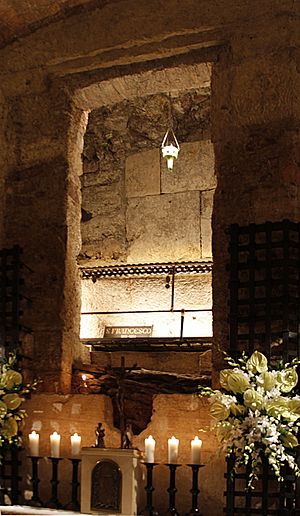
Francis's feast day is celebrated on October 4. There was once another feast day on September 17, honoring the stigmata he received. But this was later removed from the main calendar.
Francis is honored with a special day in the Church of England, the Anglican Church of Canada, and other churches on October 4.
On March 13, 2013, when he was chosen as Pope, Cardinal Jorge Mario Bergoglio from Argentina picked Francis as his papal name. He did this to honor Francis of Assisi. He said he chose the name because he cared deeply for the poor. It was the first time a pope had taken this name.
Patronage and Influence
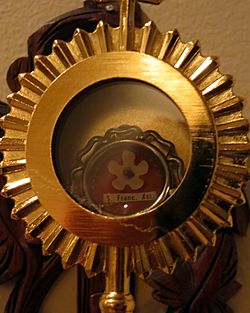
On June 18, 1939, Pope Pius XII named Francis a joint patron saint of Italy. He shares this honor with Catherine of Siena.
Francis is the patron of animals and ecology. He is also the patron saint of the Laudato Si' Movement. He is considered a patron against dying alone and against fire. He is the patron of the Franciscan Order, families, peace, and needleworkers.
Many places around the world are named after him. These include Italy, San Francisco, California, and Santa Fe, New Mexico.
Francis's Influence Outside Catholicism
Protestantism
Since the 1800s, some Protestant groups have tried to follow St. Francis's teachings. The Oxford Movement in the Anglican Church helped bring back religious orders. Some of these were inspired by Francis. Important Anglican groups include the Community of St. Francis (women, started 1905) and the Society of St. Francis (men, started 1934).
There are also small Franciscan groups in European Protestant and Old Catholic Churches. Some Lutheran Churches have Franciscan orders, like the Order of Lutheran Franciscans.
Anglican churches kept the tradition of blessing animals on or near Francis's feast day, October 4. More recently, Lutheran and other Protestant churches have also started this practice.
Orthodox Churches
Francis's feast is celebrated at New Skete. This is an Orthodox Christian monastic community in Cambridge, New York.
Other Religions
Outside of Christianity, other people and groups are inspired by Francis. These include the philosopher Eckhart Tolle, who has made videos about Francis's spirituality. The interreligious community of Skanda Vale in Wales also takes inspiration from Francis. They see themselves as an interfaith Franciscan order.
Main Writings
- Canticum Fratris Solis or Laudes Creaturarum; Canticle of the Sun
- Prayer before the Crucifix, 1205
- Regula non bullata, the Earlier Rule, 1221
- Regula bullata, the Later Rule, 1223
- Testament, 1226
- Admonitions
Some literary experts consider Francis the first Italian poet. He believed ordinary people should be able to pray to God in their own language. He often wrote in the Umbrian dialect instead of Latin.
The famous 20th-century prayer "Make Me an Instrument of Your Peace" is often said to be by Francis. However, there is no proof that he wrote it.
Francis in Art and Media
Art and Paintings
The Franciscan Order encouraged devotion to Francis after he became a saint. They asked for many artworks for Franciscan churches. These showed Francis with holy figures or scenes from his life. There are large, old fresco paintings in the Basilica of San Francesco d'Assisi.
Many paintings from the 1600s and 1700s show Saint Francis of Assisi with a musical angel. These paintings have different titles, like Francis being "consoled" or in "rapture."
- Francis of Assisi in art
-
Saint Francis of Assisi Receiving the Stigmata, Jan van Eyck, around 1430–1432
-
The Stigmatization of St Francis, Domenico Veneziano, 1445
-
Saint Francis in the Desert Giovanni Bellini, around 1480
-
Saint Francis Receiving the Stigmata, Studio of El Greco, 1585–1590
-
Saint Francis in Meditation, Francisco de Zurbarán, 1639
-
Saint Francis of Assisi in Ecstasy, Caravaggio, around 1595
-
Francis of Assisi visiting his convent while far away, in a chariot of fire, José Benlliure y Gil (1855–1937)
-
The Ecstasy of St. Francis, Stefano di Giovanni, 1444
-
Statue in Askeaton Abbey, Ireland, said to cure toothache, 14th–15th century
Films About Francis

Many films have been made about the life of Saint Francis:
- The Flowers of St. Francis (1950), directed by Roberto Rossellini.
- Francis of Assisi (1961), starring Bradford Dillman.
- Brother Sun, Sister Moon (1972), by Franco Zeffirelli.
- Francesco (1989), starring Mickey Rourke.
- Clare and Francis (2007), a film about both saints.
- The Letter: A Message for our Earth (2022), a documentary about Francis and the encyclical Laudato Si'.
Music Inspired by Francis
Francis's life has inspired many musical works:
- Franz Liszt: Cantico del sol di Francesco d'Assisi (choral work, 1862).
- William Henry Draper: All Creatures of Our God and King (hymn, 1919), based on the Canticle of the Sun.
- Paul Hindemith: Nobilissima Visione (ballet, 1938).
- Olivier Messiaen: St. François d'Assise (opera, 1975–83).
- John Michael Talbot: Troubador of the Great King (1981), an album for Francis's 800th birthday.
- Angelo Branduardi: L'infinitamente piccolo (album, 2000).
- Peter Reulein / Helmut Schlegel: Laudato si' (oratorio, 2016).
Books and Other Works
Hundreds of books have been written about Francis. Here are a few suggestions:
- Paul Sabatier, Life of St. Francis of Assisi (1905).
- Johannes Jurgensen, St. Francis of Assisi: A Biography (1912).
- Arnaldo Fortini, Francis of Assisi (1981).
- Nikos Kazantzakis, Saint Francis (1954).
- John Moorman, St. Francis of Assisi (1963).
Francis has also appeared in other works:
- In Rubén Darío's poem "Los Motivos Del Lobo" ("The Reasons of the Wolf"), St. Francis tames a wolf.
- In Fyodor Dostoyevsky's The Brothers Karamazov, Francis's name is used to describe a spiritual guide.
- Francesco's Friendly World was a 1996–97 animated series for kids. It was about Francesco and his talking animal friends.
- Rich Mullins co-wrote Canticle of the Plains, a musical based on Francis's life but set in the American West.
See Also
 In Spanish: Francisco de Asís para niños
In Spanish: Francisco de Asís para niños
- Feast of Saint Francis
- Blessing of animals
- Places named after St. Francis
- Pardon of Assisi
- Society of St. Francis
- Wolf of Gubbio
Prayers Connected to Francis
- Canticle of the Sun, a prayer written by Francis.
- Prayer of St. Francis, a famous prayer often thought to be by Francis.



